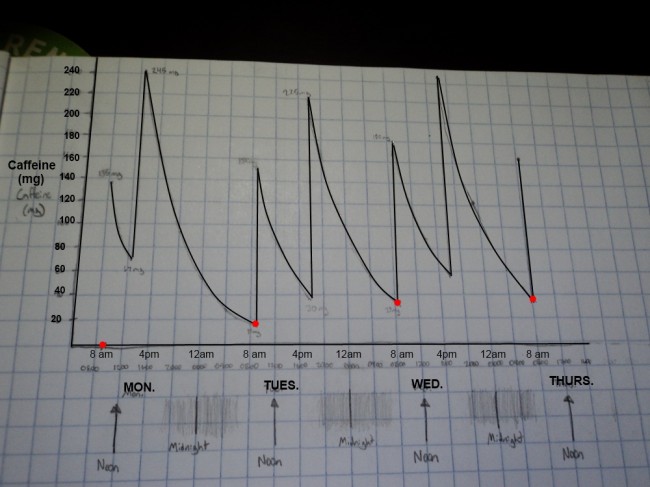Caffeine
Let’s talk caffeine.
As most college students (and many high school students) can testify, caffeine, specifically in the form of coffee, is a substance akin to blood or water in its importance to student survival. This biological dependence on/addiction to caffeine intrigued my inner mathematician (double major!), so I decided to look into caffeine as a psychoactive substance, then do some graphing, which is my only hobby.
For my experiment, I made a few unrealistic assumptions and disregarded some important facts about the digestive system, simply because I have other things to do as well (tests are not hobbies but are still very important). First, I assumed that I began Monday with zero caffeine in my body. In the spirit of science, I didn’t actually drink any coffee Sunday, so not too much of a stretch. I also assumed that the body is a closed system, wherein the only way for caffeine to exit the body is by being metabolized. This is not strictly true – some caffeine would, in reality, pass through the system without being absorbed into the bloodstream. I hope that my scientifically rigorous readers can excuse my poor theory and instead concentrate on the interesting facts yet to come!
Caffeine follows an “exponential decay” model, often referred to as a “half-life” model. The estimated metabolic half-life of caffeine varies greatly depending on the individual drinker, and is affected by things such as size, other nutrition, etc. For the average adult male, the metabolic half-life (the time it takes for half the acquired caffeine to be metabolized) is approximately 4.9 hours. Because of the scale of my graph, I rounded, so at any point, the caffeine content in my system was assumed to decrease by 50% in 5 hours. Now behold!

I am not a heavy coffee drinker – A few cups/servings a day is my normal intake. The ideas presented here are not supposed to apply to those of extremes, but to the average/moderate coffee drinker interested in how coffee is affecting the body. As illustrated in the graph, I had a normal-sized mug of coffee with breakfast on Monday, Tuesday, and Thursday, and a larger one with breakfast on Wednesday. Each of the first three afternoons, I, by curious happenstance, ended up at Starbucks to do homework or study, and each time ordered something with the equivalent of two espresso shots included (approx. 175 mg of caffeine – estimates vary widely among the resources I used). A single cup of coffee in the morning and a “grande” or medium-sized drink in the afternoon is not unusual by any means, and is indeed on the less-caffeinated end of my normal weekly spectrum. Despite this, however, because of the “exponential decay” model that caffeine metabolism (or any other metabolism) obeys, these few drinks cause an accumulation of caffeine in the system – It’s easy to see how people build tolerances to the stimulant and diuretic effects of the drug when, by day 3 or 4, I was starting out with half a serving of caffeine already camping in my body!
The rigor of this experiment was less than stellar – I forced myself to stop drinking coffee Thursday afternoon in an effort to be nutritionally and hydrated-ly (eh?) prepared for the ruck march on Sunday. Despite this, I found the resulting graph to be an interesting commentary on how easily we accumulate this psychoactive drug in our systems, and how much quicker the process could be with a marginally higher intake of caffeine. That being said, the first thing I’m doing after Melodores Gone Wild (Card) on Monday (I return about an hour before showtime) is getting coffee! Some people never learn.